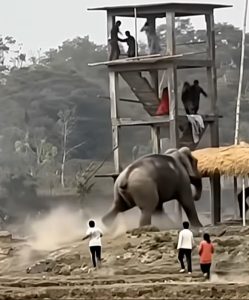In the heart of the African savanna, a quiet crisis was building. Elephants — the gentle giants known for their grace and intelligence — were clashing with human communities. Villages that once coexisted peacefully with wildlife now found themselves facing a new kind of danger: elephants wandering in, knocking down buildings, and raiding food supplies.
But this wasn’t aggression — it was desperation.
As human expansion pushed further into the wild, deforestation and development cut through ancient elephant migratory routes. With fewer resources and shrinking space, elephants began entering villages in search of food and water. At first, it was the occasional scare. But soon, their visits became more frequent — and more destructive.

People were torn. Many understood the elephants weren’t to blame. Still, the damage to homes and crops couldn’t be ignored. Something had to change.
That’s when an unexpected ally stepped in: technology.
Conservationists and local leaders teamed up with tech experts to create an early warning system. Using motion sensors, cameras, and AI-powered software, they tracked elephant movements and predicted when herds were headed toward human settlements. When one got too close, the system sprang into action — playing low-frequency sounds only elephants could hear and launching drones with lights to gently redirect them away.
It wasn’t just about tech, though. The effort also focused on education, helping villagers understand elephant behavior and how to coexist safely. Community meetings and workshops helped shift the narrative from fear to empathy.

The results? Remarkable. Elephant encounters dropped, buildings stayed intact, and tension eased. The elephants, unknowingly guided by invisible barriers, began to steer clear of villages and stick to safer paths.
What was once a growing conflict turned into a quiet success story — a reminder that with innovation, compassion, and a bit of cooperation, even the wildest challenges can find balance.





